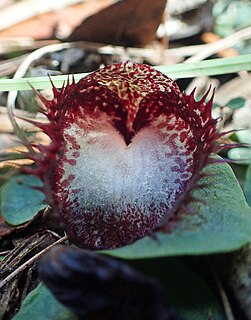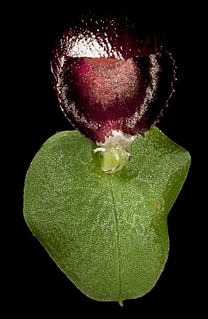Acianthus collinus, commonly known as hooded mosquito orchid or inland mosquito orchid, is a flowering plant in the orchid family Orchidaceae and is endemic to New South Wales and Victoria in Australia. It is a terrestrial herb with a single, heart-shaped leaf and between two and nine translucent pinkish flowers with reddish markings and is found growing in colonies on sheltered slopes in open forest in on the western slopes of the Great Dividing Range.

Corybas hispidus, commonly known as the bristly helmet orchid, is a species of orchid endemic to eastern Australia. It is distinguished from other helmet orchids by its autumn to winter flowering period, and by its labellum, which has a bristly-hairy, creamy-white centre and is deeply notched along its top edge.
Prasophyllum keltonii, commonly known as Kelton's leek orchid, is a species of orchid endemic to a small region of New South Wales. It has a single tubular, bright green leaf and up to twenty two scented, green, brownish-red or purplish flowers. It is a very rare orchid with only a few hundred plants known.
Genoplesium insigne, commonly known as the dark midge orchid or Wyong midge orchid, and as Corunastylis insignis in Australia, is a small terrestrial orchid which is endemic to New South Wales. It has a single thin leaf and up to twelve dark purple to dark reddish purple flowers. It is mostly found in heath on the Central Coast and only around fifty plants survive.
Genoplesium morinum, commonly known as the mulberry midge orchid and as Corunastylis morina in Australia, is a small terrestrial orchid endemic to New South Wales. It has a single thin leaf fused to the flowering stem and up to twenty crowded, dark reddish purple flowers. It has been known as "mulberries on sticks".
Genoplesium superbum, commonly known as the pink midge orchid or superb midge orchid, is a small terrestrial orchid which is endemic to New South Wales. It has a single thin leaf and up to fifteen dark pinkish-purple flowers which lean downwards. It is listed as "endangered" in New South Wales because of its limited distribution and disturbance of its habitat.
Corybas globulus is a species of helmet orchid endemic to a small area of the New England Tableland in northern New South Wales. It is a relatively small orchid with a bright green, heart-shaped leaf and a bulbous, dark reddish purple flower.
Arthrochilus prolixus, commonly known as wispy elbow orchid, is a flowering plant in the orchid family (Orchidaceae) and is endemic to eastern Australia. It has a rosette of bluish green leaves at its base and up to twenty two pale green, insect-like flowers with dark reddish to purplish glands on its labellum.
Corybas abditus, commonly known as the swamp helmet orchid or small helmet orchid , is a species of terrestrial orchid endemic to Western Australia. It is a rare orchid with a single bluish green, heart-shaped leaf and a small flower with an enlarged dorsal sepal and tube-shaped labellum.

Corybas barbarae, commonly known as fairy lanterns, is a species of terrestrial orchid endemic to eastern Australia including Lord Howe Island. It has a single dark green or reddish green, heart-shaped leaf and a small sparkling white or pinkish flower with an inflated dorsal sepal obscuring its hairy labellum.
Corybas cerasinus, commonly known as the red helmet orchid, is a species of terrestrial orchid endemic to tropical north Queensland. It has a single bluish green, heart-shaped leaf and a cherry red to dark maroon flower with its curved dorsal sepal obscuring its labellum which has an upturned tip.
Corybas dentatus, commonly known as the Lofty Ranges helmet orchid, is a species of terrestrial orchid endemic to South Australia. It has a more or less round leaf and a single purplish and green flower. It is only known from two locations and is listed as "vulnerable" under the Environment Protection and Biodiversity Conservation Act.
Corybas expansus, commonly known as the flared helmet orchid, is a species of terrestrial orchid endemic to South Australia. It has a heart-shaped to more or less round leaf and a single purplish flower with greenish or transparent areas. It is a vulnerable species, found in near-coastal sand and leaf litter.
Corybas fordhamii, commonly known as the banded helmet orchid or swamp helmet orchid, is a species of terrestrial orchid endemic to south-eastern Australia. It has an egg-shaped to heart-shaped leaf and a reddish to reddish purple flower which leans forward. It is similar to C. unguiculatis which does not grow in swamps and has a different labellum.

Corybas incurvus, commonly known as the slaty helmet orchid, is a species of terrestrial orchid endemic to south-eastern Australia. It has a broad egg-shaped to heart-shaped leaf and a dark purple flower with a white patch in the middle.
Corybas × miscellus, commonly known as the hybrid helmet orchid, is a hybrid species of terrestrial orchid endemic to South Australia and a very small area in far western Victoria. It has a heart-shaped to more or less round leaf and a single reddish purple flower with greyish translucent areas. It is a natural hybrid between C. diemenicus and C. incurvus and shares the characteristics of the parent species.
Corybas montanus, commonly known as the montane helmet orchid, is a species of terrestrial orchid endemic to Queensland. It forms small colonies and has single heart-shaped to round leaf and a reddish, self-pollinating flower with a curved dorsal sepal. It is only known from the Mount Barney National Park in south-east Queensland.

Corybas pruinosus, commonly known as the toothed helmet orchid, is a species of terrestrial orchid endemic to New South Wales. It grows in moist forests and has a single round or heart-shaped leaf and a relatively small, translucent grey flower with dark red markings.

Corybas recurvus, commonly known as the western helmet orchid or common helmet is a species of terrestrial orchid endemic to Western Australia. It has round or heart-shaped leaf and a dark reddish purple or purplish black flower. It is widespread and common between Bunbury and Albany.

Corybas undulatus, commonly known as tailed helmet orchid, is a species of terrestrial orchid endemic to eastern Australia. It has a single leaf and a single translucent grey flower with reddish markings, and a labellum with a bristly surface, fine teeth on the edge and a small tail on the tip.






